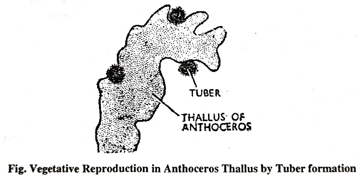Write an essay on the vegetative propagation in Bryophytes.
Q. Write an essay on the vegetative propagation in Bryophytes.
Or, Describe the various methods of vegetative reproduction in Bryophytes.
Ans. One of the characteristic features of the bryophytes is their tendency towards vegetative reproduction by a large variety of means. Correns (1899) and Cavers (1903) have collected and summarized the various methods of vegetative reproduction in bryophytes as follows:
(i) By death and decay method
In most of the thallose, dichotomously branched bryophytes, the plants reproduce vegetatively by the progressive death and decay of the older part, as the decay reaches the dichotomy, the two branches of the thallus separate from each other and begin to develop in two new thalli. This method is quite common in Riccia, Marchantia, Pellia and Anthoceros. In mosses (Bryidae) the prostrate branches die and the erect branches borne by them become independent plants.

(ii) By the formation of adventitious branches:
In this case the adventitious branches are given from the ventral surface of thallus. These adventitious branches get detached from the parent plant and form a new thalli. This method is quite common in Riccia (R. fluitans), pusilla Marchantia and in some Jungermanniales e.g. Pellia, Blasia, etc.
(iii) By the formation of innovations:
In few cases e.g. Sphagnum and some Jungermanniales, one of the upright branches of the tuft continues-growth and become independent due to death of the tissue bearing such branches.
(iv) By tuber formation :
In this method, during the unfavourable period, the gametophyte become thick along the margins and these thickened areas develops protective covering. These thickened portions are called tubers. These tubers can perennate unfavourable season and long drought while the remaining thallus dies. On the approach of favourable climatic conditions, the tubers give rise to new thalli, e.g. Anthoceros, species of Riccia (R. vesicata), etc.

(v) By Perennation during unfavourable season:
In this method, during the unfavourable period, the whole thallus except the tips get killed due to prolonged drought and heat. On the approach of the favourable conditions, these tips again resume growth and give new thalli, e.g. Riccia.
(vi) By Gammae:
Gammae formation is very common in most of the bryophytes for vegetative reproduction. But the structure and formation of gammae is slightly different in different groups of bryophytes as follows:
(A) In Hepaticae : In Marchantia, multicellular, stalked, green discoid gammae produced inside gammae cups on the dorsal surface of thallus. Each gammae produces two new thalli.
(B) In Anthocerote : In certain species gammae are formed on the dorsal surface of thallus.
(C) In Musci :Various types of gammae have been observed in various types of mosses, which help in vegetative reproduction. In some cases the multicellular gammae are formed on the tips of leaves or on the side of branches. In Funaria gammae are formed on the rhizoids, which often called as bulbils.
(vii) By the formation of primary protonema :
In musci the spores on germination form the protonemal stage of gametophyte. These protonema are known as primary protonema. These protonema are filamentous branched and gives several buds. Each bud can form a new gametophore. Sometimes the protonema breaks in fragment give rise the new protonema which again multiply and bear buds. In this way by protonema formation one spore of moss plant forms several moss plants. Formation:
(viii) By secondary Protonema :
The protonema which develops from the secondary protonema or from any living cell of the plant is known as secondary-protonema. In some cases e.g. Funaria, Sphagnum and other mosses the rhizoids come out the soil, develop chlorophyll and become just like the protonema. These secondary protonema gives rise to new gametophores like that of primary protonema. In few cases the secondary protonema may develop from the wounded portion of the leafy shoot from the marginal cell of the protonema.
Follow on Facebook page – Click Here
Google News join in – Click Here
Read More Asia News – Click Here
Read More Sports News – Click Here
Read More Crypto News – Click Here